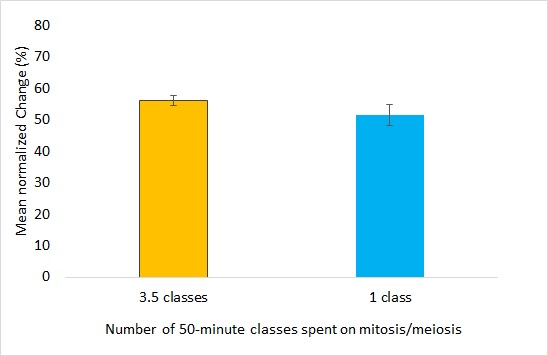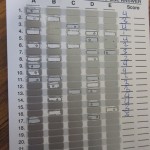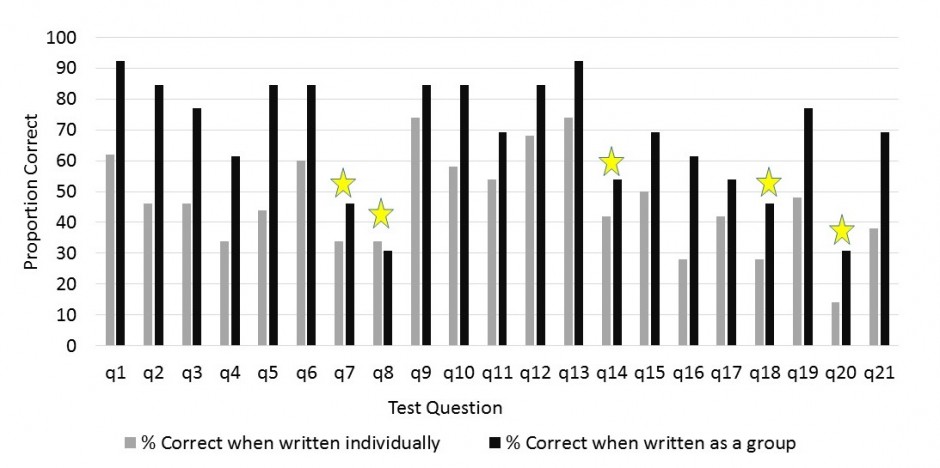Review can be a necessary part of almost any course. We expect (hope) students will bring some prior knowledge into our courses, but there are no guarantees. We all forget things, and it can be even harder to trigger prior knowledge in a new context. So, we often use class time to review required material. A problem with traditional review sessions is that students will tune out: they recognize some of the review material being shown, so they think they know this stuff, and so students are unlikely to walk away with an improved understanding of the review material. Here we describe an easy and effective way to engage students in review: the two-stage review activity. A few of us in biology have tried this review method, and have had great success.
Why: Review often takes up a significant amount of class time, but does not always deliver the desired results (i.e., “we reviewed this, why don’t they know it?”).
What: The two-stage review activity uses individual testing followed by collaborative testing. Two-stage (or collaborative) exams are becoming more common in classes here at UBC and elsewhere. One of the major benefits of two-stage exams is immediate feedback. There is good research out there on the benefits of two-stage exams, one example is found here.
How: Students complete a test individually (e.g. 5 to 20 questions, depending on the extent of review needed). The questions are testing content they should know from the pre-requisite course(s), and are generally multiple choice. After completing the individually-written test, students get into groups and re-write the same exam. They get immediate feedback for each question about whether or not their group is correct using IF-AT Scratch Cards.
“IF-AT forms are multiple-choice answer sheets with a top layer of scratch-away material, similar to a scratch lottery ticket. For each question, the student group scratches away the top layer of their chosen answer (A-E). If their answer is correct, the revealed area will contain a star. If no star is visible, the group continues to try until they scratch off the correct answer.” (Maxwell et al., 2014). We often ask groups to award themselves points based on how many scratches they make before identifying the correct answer. This provides added incentive to deeply discuss the question before their first scratch.
A review session like this can take anywhere from 15-50 minutes, and can be done in class or in tutorials. The individually-written test can also be done online, before class – reducing the in-class time to only the group component.
Want to try this, but need some help finding questions or finding scratch cards? Get in touch, we can help!
Results from using a two-stage review activity in a biology class:
- Students are very engaged in the review. Their discussions were energetic and on-topic.
- Students got immediate feedback and were able to clarify a lot of their misunderstandings through group discussion.
- We have saved three 50-minute class periods by doing this review. Typically we would spend almost 4 classes covering a topic that was also covered in the first year course. After the two-stage review we cut it down to 1 class. After the review activity, students were provided with practice problems to do as they see fit (in their own time). We cut out the in-class review, and only focused class-time on the most challenging parts of the topic. Despite dramatically reducing in-class time spent on this topic, student performance on the topic was not negatively impacted based on performance on the conceptual diagnostic test (see Figure 1). This allowed us to use the saved classes to cover new, more challenging material.
 Figure 1. Reducing the amount of in-class time spent on mitosis and meiosis does not negatively impact student performance. The 3.5 classes session received in-class, “traditional” review. In comparison, the 1 class session received the two-stage review activity and extra-curricular practice problems. Mean normalized change represents the change in score from the pre-test (before teaching mitosis/meiosis) to the post-test (after teaching). Error bars are standard error of the mean. The means are not significantly different (p>0.05,t-test).
Figure 1. Reducing the amount of in-class time spent on mitosis and meiosis does not negatively impact student performance. The 3.5 classes session received in-class, “traditional” review. In comparison, the 1 class session received the two-stage review activity and extra-curricular practice problems. Mean normalized change represents the change in score from the pre-test (before teaching mitosis/meiosis) to the post-test (after teaching). Error bars are standard error of the mean. The means are not significantly different (p>0.05,t-test).
- More than 70% of students reported taking action to correct misunderstandings revealed by the review activity, by studying old notes, reviewing old midterms) after the two-stage review experience! Over 25% of students took another test voluntarily, online, after the review activity to re-test their understanding of the review material.
- As an instructor, I also got feedback. Looking at the individual versus group scores (Figure 2), I could identify the review material that students still struggled with, even after the collaborative group test. In other words, I could focus precious in-class time and avoid reviewing everything.
Figure 2. Individual and group performance on the two-stage review test questions.
We highly recommend the two-stage review activity as an effective, and efficient, way to engage students in review. Improved understanding, saving class time, and promoting students to be self-directed learners!
If you want to talk more with us about running such an activity, please get in touch!
You can also see Dr. Jane Maxwell summary of her experience in a 300 level Chemistry class here and soon you can read more about the two-stage review in the Journal of College Science Teaching.
Maxwell, J.E., McDonnell, L.M., Wieman, C. 2014. An Improved Design for In-Class Review. Journal of College Science Teaching. Accepted.

